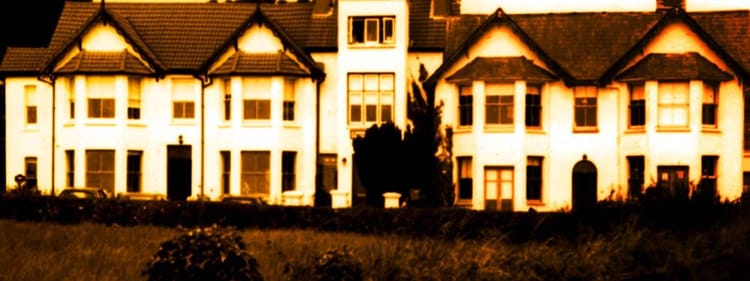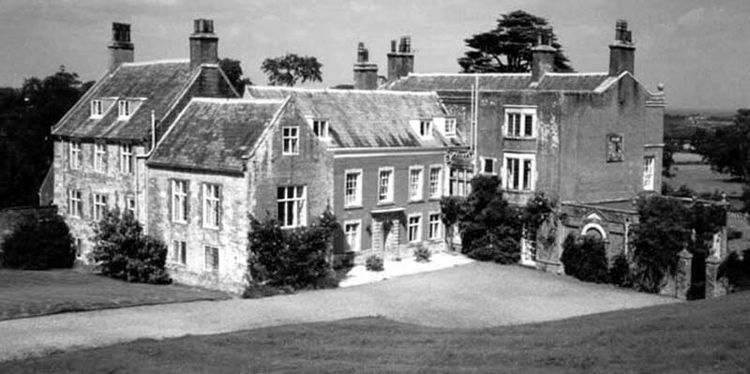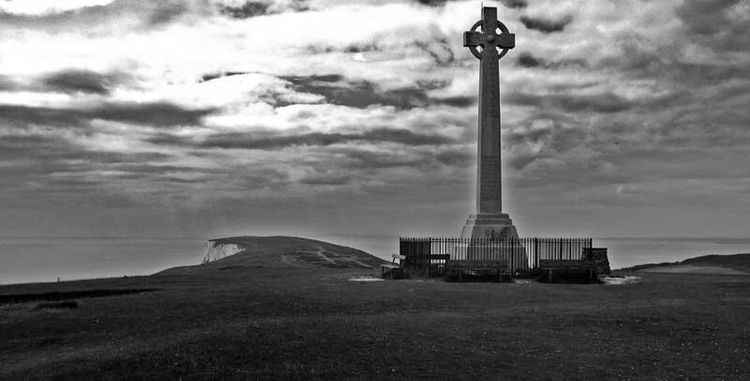St. Catherine's Tower. Ghosts of the Isle of Wight, with Margo Williams.
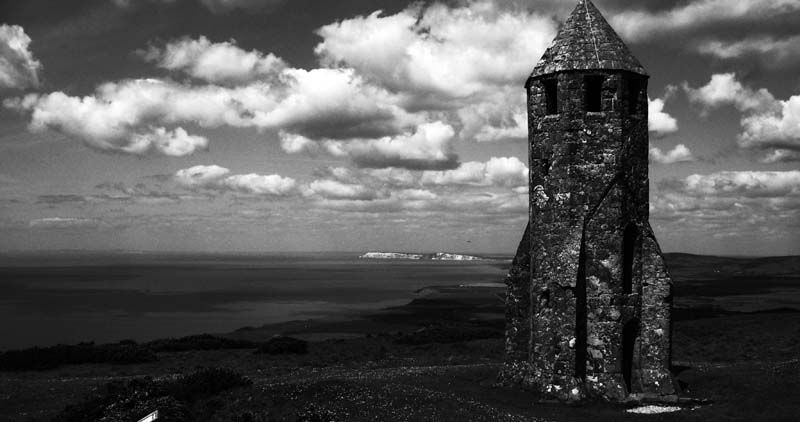
The Haunted Tower
GHOSTLY LANTERN LIGHT is sometimes seen shining in the old light tower on St. Catherine’s Down above Blackgang Chine.
Ghost hunters believe this famous haunting is caused by the supernatural lantern-work of a ghostly hermit stationed up there on lonely vigil, still warning passing ships of the notorious Bay of Death below.
Others say the ghostly lantern probably is in the hands of unlucky Sir Walter de Godeton whose new-stocked wine cellar from an opportune shipwreck in 1313 caused him to build a lighthouse, on the order of an angry pope.
When a cargo of wine on board the good ship St. Marie de Bayonne, destined for a monastery in Normandy, was sold by survivors to the islanders.
The pope found out about the wreck and sacrilegious displacement of its cargo, and in penance Sir Walter built a lighthouse and an oratory high up on Saint Catherine’s hill.
A chapel for when the mist was thick and the light failed those ships below. Somewhere in that windswept remote high wilderness a priest could pray and offer mass for the souls in peril on the sea.

The Oratory Chapel
The chapel now is gone; following King Henry VIII’s royal visit to the Isle of Wight in 1539 he awarded himself its revenue and evicted the monk, and so the light went out and prayer was silenced.
However, the tower remains standing; it is the last of Britain’s medieval light-houses. Island people refer to it more famously as the ‘Pepper Pot’.
Even though the light has long since been extinguished, some people who drive the coastal road at night swear they saw the ghostly lantern.
Local legend claims a man named Walter de Langstrell was one of the lighthouse men. And so those who see the lighthouse ghost think it may be lonely Walter doing his work, unaware a new lighthouse was built below the mist-line, and of the fact that no ships are now lost has nothing to do with his efforts.
Sometimes on calm nights in the Clarendon Bar, locals with deep connection say a light has shone from St. Catherine’s summit even long before de Godeton’s tower was raised.
They claim a Stone Age superhighway ran from Britain to the Holy Land passing via the Isle of Wight, around Blackgang Chine.
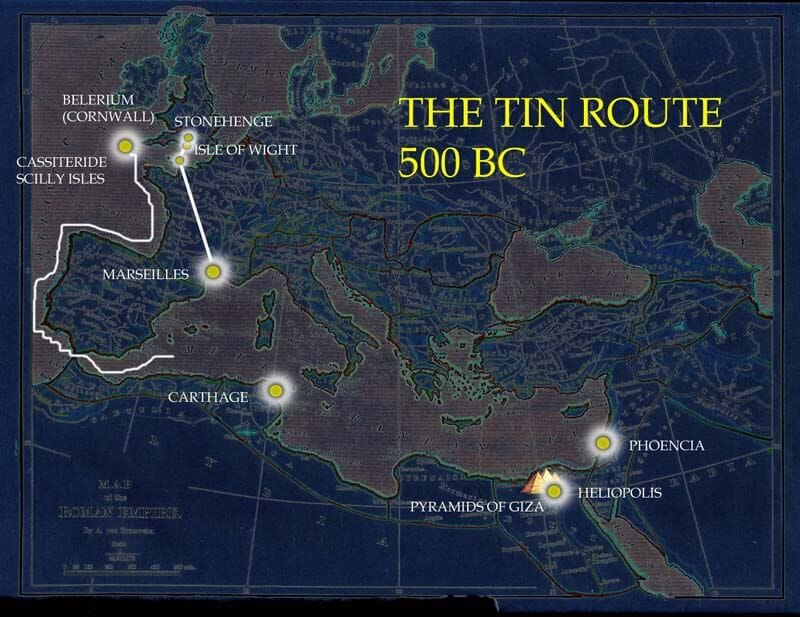
Light of Ictis Isle
This prehistoric route crossed to the opposite coast in France then overland down to Marseilles. A trail used by ancient Britons to run tin product to the pharaohs and kings of Mycenae.
When this island was named Ictis.
A route still made use of throughout the rise and fall of Roman Vectis; and most famously travelled by a tin merchant named Joseph of Arimathea. Whose final one-way ticket brought him here after the Crucifixion, carrying the Holy Grail.
Sometimes a barperson in the Clarendon Hotel would ask the obvious question knowing the consequence for the landlord’s sales of ale:
'Did Joseph get off the boat at Niton’s Puckaster Cove, on the safe side of Blackgang Chine, or trust his captain to get him and his precious cargo safe round the island and on into Hengistbury Head harbour?'
Later, the philosophy of Grail and the physics of tin may become fused into different truths.
Isle of Wight and the Holy Grail
Mythbusters say the Isle of Wight tin route is as much a fiction as the Holy Grail; not a real object anyway but more of an idea, an aspiration.
Others of mystic inclination say the Grail was a sacred secret knowledge only yielded to the sorely tested initiate, whose efforts at enlightenment would certainly be less demanding than pushing tin-laden chariots over the Solent mud.
Local pagans however claim the Grail was a sacred cauldron of abundance revered by the Celts who probably did the mud crossing to avoid the pirates intent on robbing them on a coast-hugging sea journey.
And it is certain some people still do believe the Holy Grail is out there somewhere waiting to be found; perhaps up in the valley of the Longstone, or beside good St. Joseph’s bones probably in Glastonbury Abbey.
Whatever and wherever it is, many have sought the Grail for fame, for fortune or for immortality but most to heal a broken world.
Whether it would work in the southern lands of the island is a good question, for it is a landscape as unstable as it is beautiful. From time to time land slips carry away acres of ground and cast them into the sea.
Chasms and cracks appear; deserted roads disappear into hillsides; the remains of buildings teeter at crazy angles over precipice and can be gone next day.
Sea views can be acquired overnight and grand driveways no longer lead to grand houses, only bleak and windy cliffs above the sea.

The Ghost of St Catherine's Tower
I sometimes wonder what happens to the resident ghosts of such lost buildings, are they also swept away? For they seem bound to ground, as are the living; they do not float in the air.
The ghost-body too must have weight of some sort though I don’t know if it is affected by gravity, and I forgot to ask the old tower’s ghost his opinion on that.
On a sunny but windy summer day I, together with Walter and our friend Ann, climbed to the tower in search of its ghost.
Wind roared a gale on the summit. We entered the old tower and immediately I sensed a supernatural presence.
Perhaps he had spoken to everyone who entered that tiny space of his prison but when I answered, for a moment he was silent then like a man denied reply for countless years he wouldn’t stop talking.
In that small cramped space he was up close and personal, and very much in my face.
“...’ad a shipmate, gold coins in bag, ‘ad to get ‘em,” he gabbled. Saw ‘im with too much grog. Jumped ship. ‘opeless! No value. Canvas bag, throwed it away. Kept one."
I barely kept pace with dictation.
"Came ‘ere to pray. Wife ill, three children. ‘ad to ‘ave money. Took the bag when ashore. Not gold at all. The man kept saying ‘e ‘ad four corners in a circle, the symbol of eternity. The symbol of foolishness, I thought.
My name is Matthew. You can find the last coin. No value. My sin to steal. Someone said sins forgiven if you prayed ‘ere. Now I cannot leave.
Find the coin. I will tell you.
Oh it is so wonderful to think that a seaman, a common man, still ‘as friends. I dropped the coin and buried it right on the outside of this tower, against the wall on the corner near where you are, against the stones.
I see it, washed upwards by the rains nearly to the surface.
Find it. Four corners in a circle.”
Buried Treasure
We stepped outside to that part of the wall where he directed, beside a buttress.
The sun had baked the clay soil so hard it took a while to chip the earth away with our makeshift tools of pieces of sharp stone, but after several minutes both Walter and Ann cried out together. “Look, what’s this!”
They picked it from the ground and showed me.
I felt a little disappointed, it was only a bottle top and said so.
“No it isn’t,” replied Ann. “Look!”

Inspecting more closely, I saw a dirty tarnished foreign coin with strange markings and a square hole through the centre. I stared at it and felt a strong pull back to the tower. Matthew had an explanation and an amazing musical exit.
“...When a man dangles a canvas bag in front of a poor man and boasts of gold, ‘e asks for it to be stolen,” he continued. “This I excused myself over and over again.
The coin, that was the one I kept to remind me never to steal again. Me wife ‘ad died of consumption, and God knows what ‘appened to me children. So I, Matthew Jenkins, never could reach the golden world of ‘eaven.
Then you came. I talked and you ‘eard. So now there is a coin in your possession. Now a sorrowful man who repents. I see lights, I ‘ear singing. I am going around in a circle upwards. Oh! ‘eaven! I can go, go, go!”
Identifying the Find
Following day Walter set about researching the coin and identified it as a Chinese Cash dated 1735.
He explained the symbolism of square and circle: that it was the oriental four corners of the earth and the never-ending circle of eternity; which is how it must have felt most days for poor Matthew Jenkins trapped inside the Pepper Pot.
Four corners perhaps, but others will tell you the hole is there for a cord so the coin would not be lost. Not so much a wad, but a string of cash.
The ghost of St. Catherine’s tower was not rich Walter de Godeton or lonely Walter de Langstrell; it was remorseful Matthew Jenkins whose coin was found years later by Ann and my husband, named Walter.
Small coincidence perhaps, but coincidence comes in many sizes. Although of no value in terms of money, for Matthew that coin was priceless: first it cost him, and then bought him his freedom.
Thank you for your company in this short tour of Isle of Wight mysteries. If you would like to know more of what happened to ghost hunter Margo Williams and the ghosts of St. Catherine's Tower and Chale, and other famous and forgotten ghosts, read this book. Now available from Amazon.
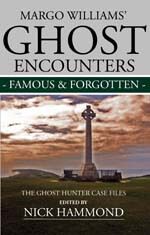
Related: Exploring the Haunted Isle of Wight.
Related: Niton. Ghosts of the Isle of Wight
